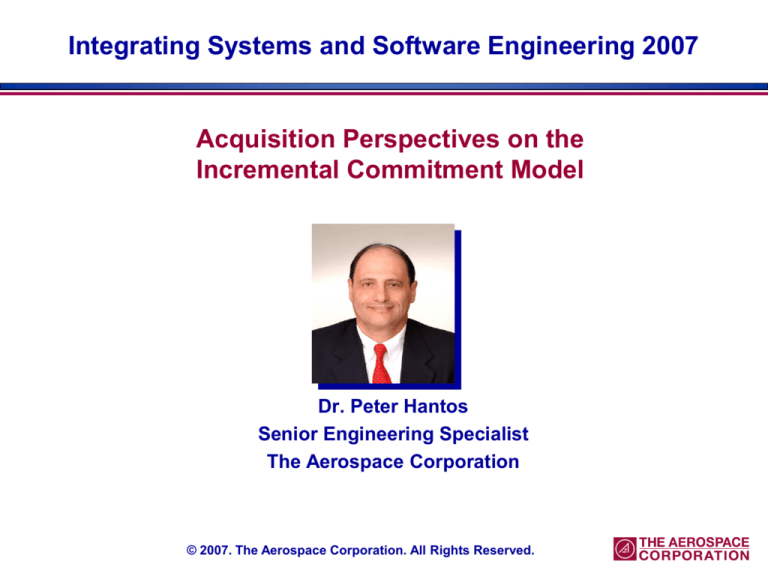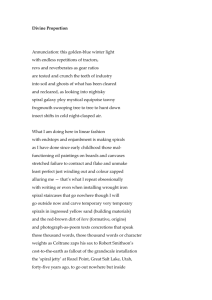
Integrating Systems and Software Engineering 2007
Acquisition Perspectives on the
Incremental Commitment Model
Dr. Peter Hantos
Senior Engineering Specialist
The Aerospace Corporation
© 2007. The Aerospace Corporation. All Rights Reserved.
Acknowledgements
• This work would not have been possible without the following:
Reviewers
– Suellen Eslinger, Software Engineering Subdivision
– Dr. Leslie J. Holloway, Software Acquisition and Process Department
– Mary A. Rich, Software Engineering Subdivision
Sponsor
– Michael Zambrana, USAF Space and Missile Systems Center,
Engineering & Architecture Directorate
Funding source
– Mission-Oriented Investigation and Experimentation (MOIE) Research
Program (Software Acquisition Task)
USC/ISSE 2007 – Peter Hantos
Slide 2
Agenda
• Objectives
• Incremental Commitment Model (ICM) – The 10,000 Foot View
• ICM and DOD (Department of Defense) Acquisition Life Cycle
Model Phases
• Evolutionary Acquisition
• Selected Evolutionary Acquisition and Spiral Development
Challenges
• Renaming Anchor Points in ICM
• Conclusions
• Acronyms
• References
USC/ISSE 2007 – Peter Hantos
Slide 3
Objectives
• Identify strengths and weaknesses of the new
Incremental Commitment Model
• Explore to what extent the new model will mitigate
known problems of the defense acquisition system
USC/ISSE 2007 – Peter Hantos
Slide 4
ICM - The 10,000-Foot View*
• Based on and inherits most characteristics of the Spiral Model
Risk-driven spiral planning is the most significant element
• The uncoiled spiral metaphor replaces spiral
Every spiral cycle maps into a life cycle phase
For depicting concurrency, builds on the well-known IBM/RUP®
diagram of core process work flows
• Major emphasis on formalized stakeholder commitment
Anchor Point (AP) reviews are renamed to Commitment
Reviews (CR)
The new Commitment Reviews emphasize life cycle phaseentry instead of phase-exit
• Most CRs are aligned with DOD 5000.2 Acquisition Life Cycle
Milestones (See next slide)
____________________
* Discussion is based on [Pew 2007]
® RUP is registered in the U.S. Patent and Trademark Office by IBM/Rational Corporation
USC/ISSE 2007 – Peter Hantos
Slide 5
ICM and DOD Acquisition Life Cycle Model Phases
Pre-Systems Acquisition
Systems Acquisition
Sustainment
DODI 5000.2.2 (12 May 2003)
A
Technology
Development
Approval
Concept
Decision
ECR
Exploration
Commitment
Review
VCR
Valuation
Commitment
Review
Exploration
ACR
Architecture
Commitment
Review
Valuation
System Development
&
Demonstration
Technology
Development
Concept
Refinement
B
System
Development &
Demonstration
Approval
USC/ISSE 2007 – Peter Hantos
DCR
OCR1
Development
Commitment
Review
Operations
Commitment
Review
Development1
Architecting2
ICM
Slide 6
Operations
&
Support
C
IOC
FOC
Design Low-Rate
Full Rate
Readiness Initial Prod
Production
Final
Review Approval Initial Approval
Operational
Operational
Capability
Capability
DCR
Architecting
Production
&
Deployment
DCR
OCR2
Operations1
Development2
Architecting3
…
Operations2
Development3
Architecting4
Evolutionary Acquisition
• Current DOD direction embraces Evolutionary
Acquisition (EA) and Spiral Development (SD)
EA is an acquisition strategy, and SD is a development
process
– Note that unique life cycle models are associated with both
Per DOD 5000.2, SD is preferred because (supposedly)
it supports EA
• Current state
EA is well understood and widely practiced
SD is still not well understood, sporadically practiced, and
many times misrepresented
The following discussion is highly relevant, since ICM is a
successor of the Spiral Model
USC/ISSE 2007 – Peter Hantos
Slide 7
Selected EA-SD Challenges
•
Uncoiling the spiral and mapping it into DOD 5000.2 phases have
been a concern from the beginning
Common interpretation is that spiral increments are mapped into
DOD 5000.2 phases
– This notion is reinforced by the fact that DOD 5000.2 requires riskidentification and risk-reduction activities in every phase
Acquisition Increment #1
Concept
Refinement
Concept
Decision
Technology
Development
System Development
& Demonstration
B
A
Production
& Deployment
Operations
& Support
Upgrade
Decision
C
System Development Spirals
Acquisition Increment #2
Technology
Development
System Development
& Demonstration
B
USC/ISSE 2007 – Peter Hantos
Production
& Deployment
C
Slide 8
Operations
& Support
Upgrade
Decision
Spiraling After Milestone B is Problematic
JROC
JROC
< 2 years
Max 2 years
Max 5 years
Current (Obligate)
PPBE/Congress
PPBE/Congress
Concept
Refinement
Expend
Expend
Current (Obligate)
Technology
Development
A
Expend
Current (Obligate)
PPBE/Congress
Concept
Decision
JROC
System Development
& Demonstration
B
Production
& Deployment
Operations
& Support
C
Upgrade
Decision
After Milestone B, system requirements must be agreed to; this is needed to secure
funding for the first acquisition increment. Spending of funds is highly constrained.
____________________
Legend: JROC: Joint Requirements Oversight Council
PPBE: Planning, Programming, Budgeting, and Execution. For details see [DODP 2003]
USC/ISSE 2007 – Peter Hantos
Slide 9
Bogeyman – The Nunn-McCurdy Breach
Reporting Thresholds
“Significant”
“Critical”
Current Baseline Estimate
Is exceeded by
+15%
+25%
Original Baseline Estimate
Is exceeded by
+30%
+50%
Congress is very closely monitoring cost growth.
Program re-baselining cannot be taken lightly.
USC/ISSE 2007 – Peter Hantos
Slide 10
“Conventional” Risk Management vs. Risk-driven
Spiral Planning in ICM Spirals
•
Conventional risk management (required by DOD 5000.2)
Fundamental characteristics
– Assigns a likelihood and impact value to the risk to facilitate prioritization
– Simple monitoring is an acceptable way of handling risks
– Most of the time a risk “burn-down” plan is put in place for risk mitigation
In all cases the contractor is supposed to have the costs associated
with risk mitigation in the baseline
– Alternative development paths and experiments might be chosen to deal
with risks, but the contracted cost and schedule must not be impacted
•
Risk-driven spiral planning
All parameters of upcoming increments are “up for grab”
Number of spirals should not be administratively limited
– In fact, spinning-off iterations with engineering objectives, even without
delivering any additional, useful functionality is an essential characteristic of
iterative development
Iteration represents a sensible engineering approach, but might
be incompatible with the overarching acquisition structure.
USC/ISSE 2007 – Peter Hantos
Slide 11
The Previously Shown Spiral Mapping Does Not Support EA
•
•
•
The previously shown mapping of spiral increments has nothing to do
with EA; those spirals are localized, internal matters of a single
acquisition increment
Spirals shown in the earlier mapping are far removed from the upgrade
decision that triggers the creation of the new acquisition increment
A more reasonable interpretation is as follows:
Acquisition Increment #1
Concept
Decision
System Development
& Demonstration
Technology
Development
Concept
Refinement
B
A
Operations
& Support
Production
& Deployment
Upgrade
Decision
C
System Development Spiral #1
Acquisition Increment #2
Technology
Development
System Development
& Demonstration
B
Production
& Deployment
Operations
& Support
C
System Development Spiral #2
USC/ISSE 2007 – Peter Hantos
Slide 12
Upgrade
Decision
Renaming Anchor Points to Commitment Reviews
in ICM
• CR equivalents of key Anchor Points
LCO (Life Cycle Objectives) ACR (Architecture Commitment
Review)
LCA (Life Cycle Architecture) DCR (Development Commitment
Review)
IOC (Initial Operational Capability) OCR (Operations Commitment
Review)
• The new naming conventions emphasize the importance of
stakeholder commitment at the entry to the next phase
Pros and cons:
– The positive impact is the reinforcement and codification of the principles
that were used to create the Win-Win extension of the Spiral Model
– The negative impact is that – inadvertedly – the Anchor Point objectives
got deemphasized
USC/ISSE 2007 – Peter Hantos
Slide 13
Conclusions
•
•
Strengths:
ICM is a promising, new, development life cycle model
Recent ICM publications do contribute to the better understanding
of spiral development principles
In ICM the original spiral graphical metaphor has been replaced
with the uncoiled spiral, making the model’s use easier for project
managers
ICM emphasizes the importance of gaining stakeholder
commitment before progressing to the next life cycle phase
Weaknesses:
The renaming of APs to CRs deemphasized the earlier, important
notion in the Spiral Model that all activities in a spiral increment are
focusing on the satisfaction of the objectives of the upcoming
Anchor Point
The mapping of ICM Anchor Points into the DOD 5000.2
milestones is artificial and not supportive of either the DOD 5000.2
Instruction in general, or its preferred, Evolutionary Acquisition
strategy in particular
USC/ISSE 2007 – Peter Hantos
Slide 14
Acronyms
ACR
AP
CR
DAPA
DCR
DOD
EA
ECR
FOC
ICM
IOC
JROC
LCA
LCO
MOIE
OCR
PPBE
SD
VCR
Architecture Commitment Review
Anchor Point
Commitment Review
Defense Acquisition Performance Assessment
Development Commitment Review
Department of Defense
Evolutionary Acquisition
Exploration Commitment Review
Final Operational Capability
Incremental Commitment Model
Initial Operational Capability
Joint Requirements Oversight Council
Life Cycle Architecture
Life Cycle Objectives
Mission-Oriented Investigation and Experimentation
Operations Commitment Review
Planning, Programming, Budgeting, and Execution
Spiral Development
Valuation Commitment Review
USC/ISSE 2007 – Peter Hantos
Slide 15
References
DODI 2003 DOD 5000.2 Instruction on the Operation of the Defense Acquisition
System, May 12, 2003
DODP 2003 DOD 7045.14 The Planning. Programming, And Budgeting System
(PPBS); Certified current November 21, 2003
PEW 2007 Pew, R., & Mavor, A., Human-System Integration in the System
Development Process: A New Look, National Academies Press, 2007
USC/ISSE 2007 – Peter Hantos
Slide 16
Contact Information
Peter Hantos
The Aerospace Corporation
P.O. Box 92957-M1/112
Los Angeles, CA 90009-2957
Phone: (310) 336-1802
Email: peter.hantos@aero.org
USC/ISSE 2007 – Peter Hantos
Slide 17
All trademarks, service marks, and trade names are the
property of their respective owners
USC/ISSE 2007 – Peter Hantos
Slide 18







